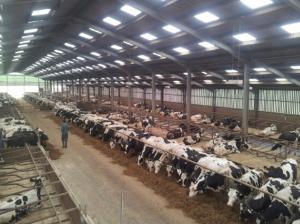Managing carbohydrate overload of the rumen
Published: 16 December 2014
Research in production animal health is working on multiple related, collaborative projects with industrial partners intended to maximise animal welfare and efficiency of production.
 Ruminants have evolved to accommodate microorganisms that can digest fibrous feeds, which are generally low in soluble carbohydrates (starch and sugars) but high in insoluble carbohydrates (cellulose and pectins). However, the growth rate and lactational performance of ruminants can be dramatically increased by feeding concentrates with high levels of starch, a soluble carbohydrate. There is a limit to how much starch a cow can be fed before the rumen content becomes too acidic to maintain a healthy microbiome.
Ruminants have evolved to accommodate microorganisms that can digest fibrous feeds, which are generally low in soluble carbohydrates (starch and sugars) but high in insoluble carbohydrates (cellulose and pectins). However, the growth rate and lactational performance of ruminants can be dramatically increased by feeding concentrates with high levels of starch, a soluble carbohydrate. There is a limit to how much starch a cow can be fed before the rumen content becomes too acidic to maintain a healthy microbiome.
Prof. Nick Jonsson’s group is working on three related, industry-funded projects intended to optimise the feeding of high energy concentrates to cattle. One project is a BBSRC Industrial Partnership Award, led by University of Aberdeen, with University of Strathclyde, Harbro, Chr. Hansen, AB Vista, Quality Meat Scotland and DairyCo support. This project is a field study to characterise the pathology associated with high levels of soluble carbohydrate feeding and to identify new probiotics for cattle to prevent acidosis.
Another project, funded by AB Vista, is comparing the metabolomic, metagenomic, and transcriptomic responses to concentrate feeding of cattle and sheep, with a view to determining the extent to which sheep can substitute as a model for cattle.
A third study is a collaboration between Well Cow Ltd; Silent Herdsman and the University of Glasgow to develop a new device for monitoring rumen function.
First published: 16 December 2014
Find out more:
Current staff involved in the research:
- Professor Nick Jonsson

